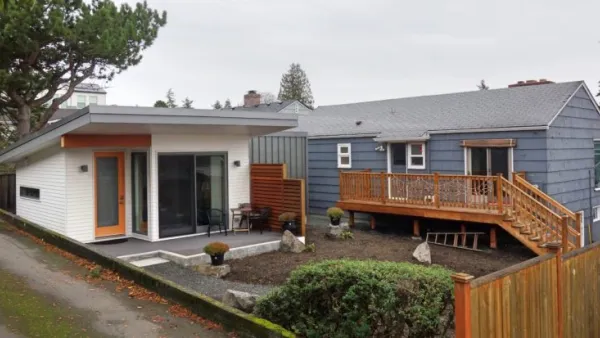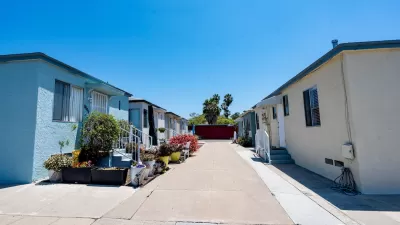Architect Teddy Cruz examines the south-north flow of "nonconforming urbanism" in the Tijuana-San Diego region, and how changing communities in this dynamic area could shape the way we think about increasing density.
"These illegal flows are physically manifested, in one direction, by the informal land use patterns and economies produced by migrant workers flowing from Tijuana into San Diego, lured by the strong economy of Southern California. But while human flow mobilizes northbound in search of dollars, the urban waste of San Diego moves in the opposite direction, where it is used to construct emergency housing in the shantytowns of Tijuana."
"As the Latin American diaspora travels north, it inevitably alters and transforms the fabric of San Diego's subdivisions. In these neighborhoods, multigenerational households of extended families shape their own programs of use, taking charge of their own micro-economies in order to maintain a standard for the household. The result: nonconforming uses and high densities that reshape the fabric of the residential neighborhoods where they settle. Alternative social spaces spring up in large parking lots; informal economies such as flea markets and street vendors appear on vacant properties. Housing additions in the shape of illegal companion units are plugged in to existing suburban dwellings to provide affordable living."
"The areas of San Diego that have been most impacted by this nonconforming urbanism are concentrated in its first ring of suburbanization. The mutation of these older bedroom communities--from rigid, monocultural and one-dimensional environments to informal, multicultural and cross-programmed communities--opens the question: how do we anticipate density? It may be that the future of Southern California urbanism will be determined by tactics of retrofit and adaptation, making the large small."
FULL STORY: A City Made of Waste

Maui's Vacation Rental Debate Turns Ugly
Verbal attacks, misinformation campaigns and fistfights plague a high-stakes debate to convert thousands of vacation rentals into long-term housing.

Planetizen Federal Action Tracker
A weekly monitor of how Trump’s orders and actions are impacting planners and planning in America.

In Urban Planning, AI Prompting Could be the New Design Thinking
Creativity has long been key to great urban design. What if we see AI as our new creative partner?

King County Supportive Housing Program Offers Hope for Unhoused Residents
The county is taking a ‘Housing First’ approach that prioritizes getting people into housing, then offering wraparound supportive services.

Researchers Use AI to Get Clearer Picture of US Housing
Analysts are using artificial intelligence to supercharge their research by allowing them to comb through data faster. Though these AI tools can be error prone, they save time and housing researchers are optimistic about the future.

Making Shared Micromobility More Inclusive
Cities and shared mobility system operators can do more to include people with disabilities in planning and operations, per a new report.
Urban Design for Planners 1: Software Tools
This six-course series explores essential urban design concepts using open source software and equips planners with the tools they need to participate fully in the urban design process.
Planning for Universal Design
Learn the tools for implementing Universal Design in planning regulations.
planning NEXT
Appalachian Highlands Housing Partners
Mpact (founded as Rail~Volution)
City of Camden Redevelopment Agency
City of Astoria
City of Portland
City of Laramie





























